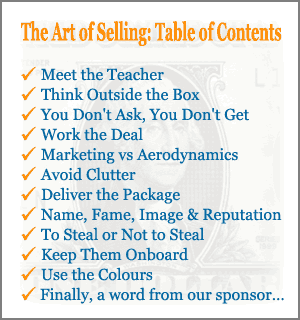
|
|

The Art of Selling: Sponsorship 101
|
|
|
By David Cameron, Italy
Atlas F1 Magazine Writer
Money makes the world go round, and Formula One needs more fuel than most. But how do the teams bring in the cash? How does a worldwide brand name end up on an F1 car? David Cameron interrogated one of the paddock's most influential money men, Williams's head of marketing Jim Wright, and obtained the secrets that landed his team Budweiser and NiQuitinCQ, among others. The result is an unprecedented guide to the world of F1 sponsorship. Paul and Eddie, take note... |
 Table of Contents includes links to each chapter
Table of Contents includes links to each chapter
|
|
The term clutter was developed to describe the effect of something being overbranded, where too many sponsor logos are added and as a result they bleed into each other, causing a melange of unrecognisable colours. Look at the side of most Nascar vehicles for an example of this. Clutter is the enemy of a team's marketing department, and WilliamsF1 have been at the forefront of amending traditional on-car signage to minimise the effect. "If you look at research of the visibility of cars with a lot of clutter, then the brand recognition of individual sponsors is pretty poor because of the clutter.
"The way we've structured our deal with BMW is to identify a certain number of positions that can be sold, and you might look at the car and say 'why haven't they put a sponsorship sticker there?' and that's because that area of the car is deemed fallow - it's not for sale. BMW are paying us a lot of money to have the blue and white colour code, to call it the BMW Williams Formula One team, and to have a restricted number of spaces for sponsorship. And that's a right we sold them, and in return they are giving us a lot of cash.
"But that said, I think people do accept that the blue and white and the BMW styling has produced a modern day icon - I wouldn't claim it's in the league of the black and gold JPS [Lotus], but I think it's certainly envied, and it's a very distinctive styling which has been admired. And I think the benefit - and this is something we talked about earlier - is having a limited number of brands within the team, and having those brands in a clear space with an exclusion zone around it to create clear visibility, and what they lose on colouring they perhaps gain on placement and clarity and recognition. So it's a balance. It's tough, but I repeat that BMW have paid for that right, so we gain there, we lose there." Is colour coding the future of sponsorship in Formula One? Probably; many of the teams are already looking towards a similar move for their on-car signage, if they haven't already. "Well I think they have. McLaren - it hurts me to say it! - probably were the forerunners of this, and they have done a fantastic job and I'm full of admiration for Ekram Sami (Head of Marketing for McLaren) and the work he does. Ferrari have a different approach, but I think they've realized having hundreds of stickers on the car without clear, defined areas doesn't work, so they've had to clean it up over the last few years, but it probably still looks a little bit messy in comparison with our car or McLaren. "I think that the other teams will follow, but it's difficult because if you go off in a particular direction and say 'that's what we're going to do' and then someone comes along waving a cheque at you and says 'I'll go with you but only if you break that rule', if you're struggling for money then you have to take the cash. And we have to take the cash - we have to find the money. "The difference with us is we're operating from a higher platform, and we go into battle - or negotiations with sponsors - saying this is a prerequisite. Budweiser is the most recent example, and one associates Budweiser with red, but actually if you look at the bottle or can Budweiser is actually written in blue, on white - it's just the surround that is red. "So what we say is 'on the car it's got to be blue and white, and these are reasons why, but in your communications, your advertising, your poster sites or whatever, you can clearly introduce the red colouring as long as the car remains faithfully blue and white'. And most smart marketing people accept that, and realise the value of it, and they may negotiate a better deal by saying 'look, we can't have our full corporate colours here therefore we're going to devalue it and pay x, because that's the value we put on it', but that's a compromise you have to reach." © 2007 autosport.com
. This service is provided under the Atlas F1 terms and conditions.
Please Contact Us for permission to republish this or any other material from Atlas F1. |
|